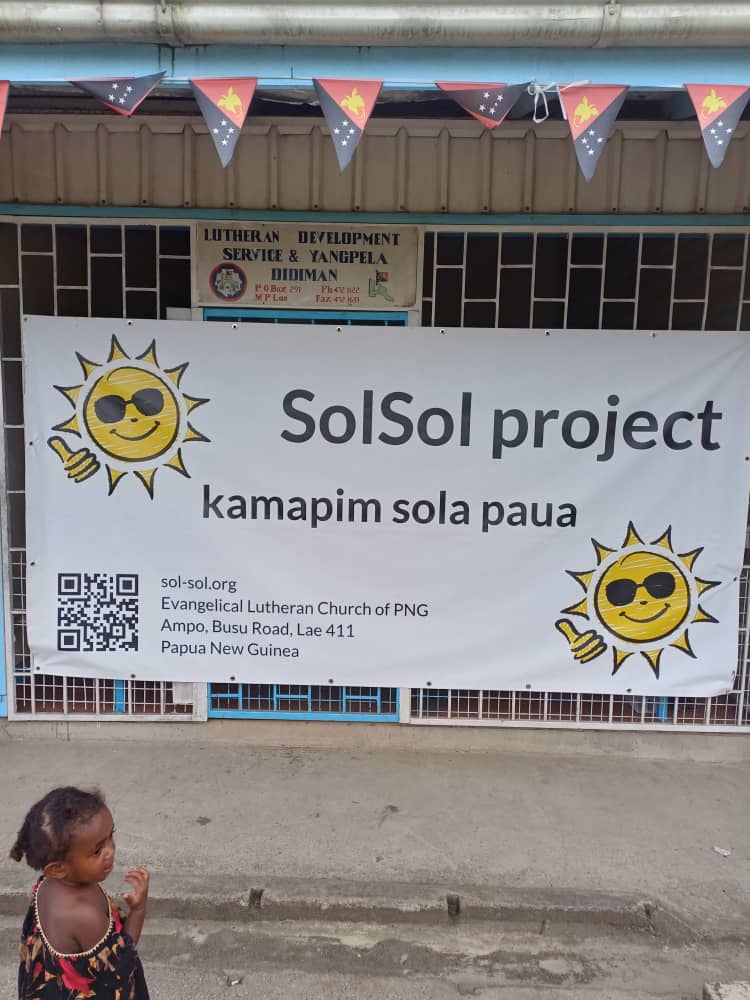
The lights have officially come on at Malahang. Following a successful hands-on training from 11–13 November 2025, six locally selected trainees worked with the Sol-Sol team to install the first solar power system at the Lutheran Development Service (LDS) compound. Fourteen solar panels now sit on the roof of the LDS office building, connected to a battery system that feeds an inverter with a capacity of 10 kVA, fully powering the office. Cabling is underway to connect three staff houses, the workshop, and the guesthouse, six buildings in total. Change-over switches are being installed so each building can instantly switch to solar during blackouts, powering lights, refrigerators, kettles, and other essential appliances just as reliably as mains electricity. The Malahang setup will serve as the prototype and the first training hub for all future Sol-Sol installations.
As one of the largest churches in Papua New Guinea, ELCPNG has long taken an active role in addressing environmental and climate challenges affecting communities across the country. Through its advocacy on issues such as sustainable land use, safeguarding marine ecosystems, and speaking against harmful practices like Deep Sea Tailings Placement (DSTP), the Church continues to uphold its moral responsibility to protect God’s creation. The Sol-Sol project is part of this wider commitment, an intentional, practical step toward reducing dependence on fossil fuels, lowering carbon emissions, and promoting clean, renewable energy across rural institutions. By investing in solar power, ELCPNG affirms that caring for people also means caring for the environment that sustains them.
But what is the Sol-Sol Project?
Sol-Sol is a new and transformative initiative of the Evangelical Lutheran Church of Papua New Guinea, currently hosted as a programme under Lutheran Development Service (LDS), and envisioned to grow into a fully-fledged standalone project as it expands.
Papua New Guinea continues to struggle with one of the most severe electricity access gaps in the Pacific. Across the country, frequent blackouts, ageing infrastructure, and an overstretched national grid mean that only about 15–20 percent of the population has reliable access to power. In rural areas, where nearly 85 percent of Papua New Guineans live, most families, schools, churches, and health centres remain unconnected to any dependable source of electricity. Many rely on small generators, candles, or battery torches, while essential services such as clinics, hospitals, and boarding schools operate under chronic energy shortages, affecting everything from student learning to life-saving medical care.
It is within this reality that the Evangelical Lutheran Church of Papua New Guinea (ELCPNG) has taken an important step by initiating the Sol-Sol Rural Solar Electrification Project, a transformative, long-term plan to bring clean and reliable solar power into remote church-run communities. Sol-Sol’s vision is that, by 2030, most ELCPNG institutions in rural areas, schools, health facilities, seminaries, mission stations, and nearby villages, will enjoy dependable electricity generated locally through stand-alone solar power stations.
The mission of Sol-Sol is built on two pillars: providing sustainable power and equipping communities to manage it. The concept goes beyond simply installing solar panels; it includes setting up localized energy hubs, training local people to operate, maintain, and monitor the systems, and ensuring that each installation becomes part of a long-term, community-owned energy solution.
The need is clearly reflected in Sol-Sol’s list of priority sites. At Etep Rural Hospital, unreliable hydro power threatens clinical services and medical equipment. At Tarabo Lutheran High School, a diesel generator is costly and inconsistent, leaving students and staff without dependable lighting at night. Senior Flierl Seminary at Logaweng, with its many staff homes and student families, struggles to maintain power for water pumps, classrooms, households, and campus services. These locations, and many more across the church, illustrate why a dedicated, renewable solution is urgently needed.
To support sustainability, Sol-Sol has designed a unique Engineering School concept. The school will train local young men and women in installation, system design, quality assurance, and energy management. Trainees will gain the skills to support and maintain the solar stations in their own communities, ensuring long-term reliability and reducing dependence on external technicians or distant suppliers.
The project is guided by a committed team under the ELCPNG Church Executive, with a steering committee that includes leaders from Lutheran Development Service (LDS), Health, Education, and Ministerial Training departments. The initiative was pioneered by Dr. techn. Markus Uhlirz, the son of a former German missionary who grew up in Finschhafen before returning to Germany, where he became a telecommunications and renewable-energy engineer and later a managing director with decades of technical and leadership experience. His strong conceptual thinking, hands-on engineering approach, and long-standing connection to PNG shaped the Sol-Sol technical vision. Reflecting on the purpose of the initiative, he says, “Abundant sunshine is God’s gift to PNG and we have ignored this valuable present till today.” His conviction, combined with the full support of the Church Executive, led LDS to host Sol-Sol as a formal programme—one expected to grow into a fully fledged, standalone project as implementation expands.
After months of planning, Sol-Sol has now taken its first major practical step. From 11–13 November 2025, the project conducted its inaugural training session at Malahang as part of establishing a prototype and training site there. According to Project Manager Bonnie Keoka, six people completed the first training course. During the same period, the team successfully carried out the first solar installation at the LDS compound in Malahang. Fourteen solar panels now sit on the roof of the LDS office building, connected to a battery system that feeds an inverter with a capacity of 10 kVA, are now fully powering its operations.
The next phase involves extending power from the office to three staff houses, the workshop, and the guesthouse, six buildings in total. Cabling work is now underway, along with the installation of change-over switches, enabling each building to switch instantly to solar power during blackouts and operate essential appliances such as lighting, refrigerators, kettles, and office equipment just as they would on mains electricity.
The Malahang setup will serve as the prototype for all future Sol-Sol installations. It is designed to function both as a practical demonstration site and as a training hub where future technicians will learn hands-on skills before deployments to mission stations, health centres, schools and seminaries across the country.
As Sol-Sol continues to grow, funding applications are progressing, technical partnerships, including UniTec Lae and MAF-Tech, are strengthening, and community engagement is expanding. The project’s first successful installation at Malahang marks a hopeful beginning, symbolizing what is possible when faith, vision, technology and community come together.
Sol-Sol’s journey is only beginning, but its first lights in Malahang shine as a powerful sign of the transformation that clean energy can bring to Papua New Guinea’s rural heartland.
For more information on the Sol Sol Project, you can visit their website at https://www.sol-sol.org


